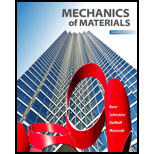
Concept explainers
(a)
Find the magnitude
(a)
Answer to Problem 116P
The magnitude of the maximum residual shearing stress
The location of the maximum residual shearing stress
Explanation of Solution
Given information:
The radius of the solid shaft
The shear stress
The rigidity modulus of steel (G) is 77.2 GPa.
The length of the solid shaft
The angle of twist
Calculation:
Calculate the maximum shearing strain
Here, c is radius of solid shaft,
Substitute 16 mm for c,
Calculate the shearing strain
Here,
Substitute 145 MPa for
Calculate the distribution of shearing strain using the relation.
Modify the Equation (1).
Here,
Substitute
Find the polar moment of inertia (J) using the relation.
Here, c is radius of solid shaft.
Substitute 16 mm for c.
Calculate the magnitude of torque
Substitute
Calculate the magnitude of torque in unloading
Substitute
Calculate the shearing stress in unloading
Substitute
Calculate the shearing stress in unloading
Substitute
Calculate the angle of twist in unloading
Substitute
Calculate the residual shearing stress
Substitute 145 MPa for
Find the residual shearing stress
Substitute 145 MPa for
Comparing the above
The magnitude of the maximum residual shearing stress
The location of the maximum residual shearing stress
(b)
Find the permanent angle of twist
(b)
Answer to Problem 116P
The permanent angle of twist
Explanation of Solution
Given information:
The angle of twist
Calculation:
Calculate the permanent angle of twist
Here,
Substitute
The permanent angle of twist
Want to see more full solutions like this?
Chapter 3 Solutions
Mechanics of Materials, 7th Edition
- Please draw the section view of the following problemsarrow_forward7) Please draw the front, top and side view for the following object. Please cross this line outarrow_forwardA 10-kg box is pulled along P,Na rough surface by a force P, as shown in thefigure. The pulling force linearly increaseswith time, while the particle is motionless att = 0s untilit reaches a maximum force of100 Nattimet = 4s. If the ground has staticand kinetic friction coefficients of u, = 0.6 andHU, = 0.4 respectively, determine the velocityof the A 1 0 - kg box is pulled along P , N a rough surface by a force P , as shown in the figure. The pulling force linearly increases with time, while the particle is motionless at t = 0 s untilit reaches a maximum force of 1 0 0 Nattimet = 4 s . If the ground has static and kinetic friction coefficients of u , = 0 . 6 and HU , = 0 . 4 respectively, determine the velocity of the particle att = 4 s .arrow_forward
- Calculate the speed of the driven member with the following conditions: Diameter of the motor pulley: 4 in Diameter of the driven pulley: 12 in Speed of the motor pulley: 1800 rpmarrow_forward4. In the figure, shaft A made of AISI 1010 hot-rolled steel, is welded to a fixed support and is subjected to loading by equal and opposite Forces F via shaft B. Stress concentration factors K₁ (1.7) and Kts (1.6) are induced by the 3mm fillet. Notch sensitivities are q₁=0.9 and qts=1. The length of shaft A from the fixed support to the connection at shaft B is 1m. The load F cycles from 0.5 to 2kN and a static load P is 100N. For shaft A, find the factor of safety (for infinite life) using the modified Goodman fatigue failure criterion. 3 mm fillet Shaft A 20 mm 25 mm Shaft B 25 mmarrow_forwardPlease sovle this for me and please don't use aiarrow_forward
 Elements Of ElectromagneticsMechanical EngineeringISBN:9780190698614Author:Sadiku, Matthew N. O.Publisher:Oxford University Press
Elements Of ElectromagneticsMechanical EngineeringISBN:9780190698614Author:Sadiku, Matthew N. O.Publisher:Oxford University Press Mechanics of Materials (10th Edition)Mechanical EngineeringISBN:9780134319650Author:Russell C. HibbelerPublisher:PEARSON
Mechanics of Materials (10th Edition)Mechanical EngineeringISBN:9780134319650Author:Russell C. HibbelerPublisher:PEARSON Thermodynamics: An Engineering ApproachMechanical EngineeringISBN:9781259822674Author:Yunus A. Cengel Dr., Michael A. BolesPublisher:McGraw-Hill Education
Thermodynamics: An Engineering ApproachMechanical EngineeringISBN:9781259822674Author:Yunus A. Cengel Dr., Michael A. BolesPublisher:McGraw-Hill Education Control Systems EngineeringMechanical EngineeringISBN:9781118170519Author:Norman S. NisePublisher:WILEY
Control Systems EngineeringMechanical EngineeringISBN:9781118170519Author:Norman S. NisePublisher:WILEY Mechanics of Materials (MindTap Course List)Mechanical EngineeringISBN:9781337093347Author:Barry J. Goodno, James M. GerePublisher:Cengage Learning
Mechanics of Materials (MindTap Course List)Mechanical EngineeringISBN:9781337093347Author:Barry J. Goodno, James M. GerePublisher:Cengage Learning Engineering Mechanics: StaticsMechanical EngineeringISBN:9781118807330Author:James L. Meriam, L. G. Kraige, J. N. BoltonPublisher:WILEY
Engineering Mechanics: StaticsMechanical EngineeringISBN:9781118807330Author:James L. Meriam, L. G. Kraige, J. N. BoltonPublisher:WILEY





